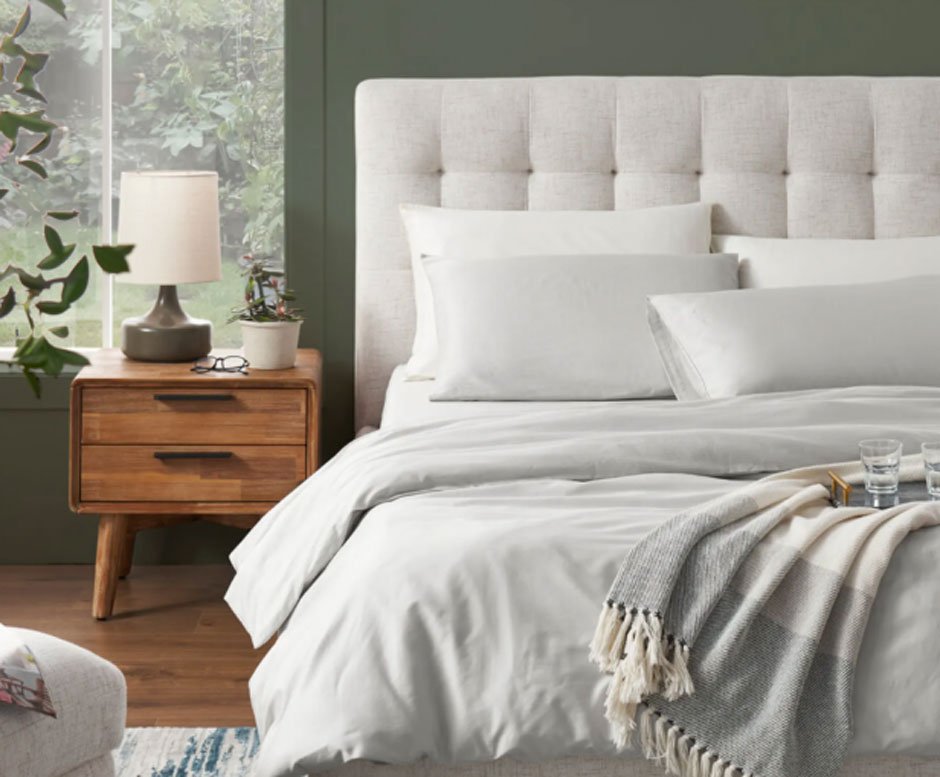 Quality sleeping begins with quality bedding, and at the heart of a cosy bed is the perfect set of sheets. The right bedding can make the difference between peacefully drifting into dreamland and tossing and turning all night. So, how do you select the perfect bed sheets? From material and thread count to size and styling, we’ll cover the key features that help you make the right decision and enhance the quality of your sleep.
Quality sleeping begins with quality bedding, and at the heart of a cosy bed is the perfect set of sheets. The right bedding can make the difference between peacefully drifting into dreamland and tossing and turning all night. So, how do you select the perfect bed sheets? From material and thread count to size and styling, we’ll cover the key features that help you make the right decision and enhance the quality of your sleep.
What Matters When Shopping for Bed Sheets?
What makes a good bed sheet? One of the first features to consider is breathability – sheets should allow air circulation to prevent overheating during sleep. Look for fabrics that naturally wick moisture away from your body and maintain a comfortable temperature throughout the night.
Durability ranks high on the list as well. High-quality sheets will withstand repeated washing without pilling, fading, and loss of softness. Construction, fabric quality, and finishing processes all contribute to how sheets will wear and tear over the long term. Consider ease of care as well – some fabrics require special care, but others can be machine washed and dried with minimal fuss.
Colour fastness keeps your sheets looking good wash after wash. Hypoallergenic properties also matter, especially if you have sensitive skin or allergies. And of course, the overall feel against your skin – whether you prefer crisp and smooth or soft and snug – must come into play.
What Sheet Dimensions Do You Need for a Super King Bed?
Super king size beds are properly massive, and they require sheets that fit their size. This means approximately 180cm x 200cm for the base, plus the additional depth to go over the thickness of the mattress, typically 25cm to 40cm deep, depending on the depth of your mattress.
When you buy super king bed sheets, always check the exact measurements because there can be a slight variation between different manufacturers. Some brands provide “deep pocket” alternatives that fit thicker mattresses, such as those with mattress toppers. It’s best to measure your mattress dimensions and depth before buying to ensure a good fit that won’t bunch or slip easily. A premium super king sheet provides ample coverage and stays in place during the night.
Flat vs. Fitted Sheets: Deciding What’s Best
The fitted versus flat sheet debate typically comes down to a matter of personal preference and functionality. Fitted styles have elasticised edges that wrap around the corners of the mattress to create a tight, tailored fit that stays in place throughout the night. They are particularly handy for restless sleepers or for those who have thick mattresses that would cause flat sheets to shift.
Flat sheets allow for flexibility and ease of maintenance. They are simpler to fold, store, and iron if needed. Many people prefer the hotel-like feel of crisp, flat sheets that can be tucked in tightly for a tidy, structured appearance. Flat sheets also last longer since there’s no elastic that will break down over time.
For optimal comfort and convenience, many opt for fitted bottom sheets combined with flat top sheets. This provides the stability of a fitted base with the classic comfort and adjustability of a flat top sheet. The choice depends on your sleeping habits, preferences, and maintenance wishes.
Thinking About Fabric Options
Cotton remains the gold standard for bed sheets, offering breathability, durability, and comfort. Percale cotton provides a crisp, cool feel perfect for hot sleepers, and sateen cotton offers a silkier, more luxurious feel with a soft sheen. Egyptian and Pima cotton varieties are high-end options with longer fibres that yield softer, stronger fabrics.
Brushed cotton undergoes a special finishing process in which the fabric’s surface is raised, resulting in a soft, flannel-like texture. This is an excellent option for colder months, as it provides extra warmth and comfort. Brushed cotton sheets feel soft immediately and have a short break-in time.
Mulberry silk is the pinnacle of luxurious bedding. These sheets naturally regulate temperature and keep you cool during summer and warm during winter. The smoothness of silk reduces friction against hair and skin, making it the perfect choice for people with sensitive skin.
Blended fabrics combine different materials to achieve a balance of performance, comfort, and affordability. Cotton-polyester blends are wrinkle-resistant and more durable, while cotton-bamboo blends are more moisture-wicking with natural antimicrobial properties. These options are generally excellent middle-ground solutions for a variety of needs and budgets.
Decoding Thread Count
Thread count is the measurement of the number of horizontal (weft) and vertical (warp) threads per square inch. Although commonly referred to as the indicator of quality, thread count only tells half the story. The sweet spot for a decent-quality super king sheet is 200 to 400 thread count. Below 200 can be thin or rough, and higher than 400 doesn’t always translate into proportional comfort or quality gains. Extremely high thread counts (800+) typically imply multiple-ply threads or inferior fibres compensating for it in quantity rather than quality.
More importantly than thread count alone is the integrity of the individual fibres and the weaving process. Single-ply threads made of long-staple cotton will create better sheets than multi-ply threads of higher counts. Weave pattern – whether percale, sateen, or twill – plays a huge role in feel and performance regardless of thread count.
Seek out quality brands that focus more on fibre quality and construction rather than thread count itself. A 300 thread count sheet that is constructed well from high-quality cotton will typically outlast and outperform a 1000 thread count sheet made of lesser quality materials.
Making Your Final Decision
The perfect super king size sheets combine comfort, durability, and practicality to enhance your sleeping experience. Consider your sleeping habits, climate, and lifestyle when selecting bed sheets. Hot sleepers would benefit more from breathable fabrics like percale cotton, while cold sleepers might prefer brushed cotton or sateen weaves.
Think about maintenance requirements. Some fabrics need special care that might not suit busy lifestyles. Balance initial cost with durability. Higher-quality sheets may cost more at the outset but may provide better value through a longer lifespan and continued comfort.








Leave a Reply